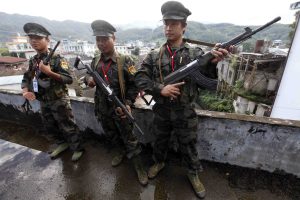An ethnic Kachin group in northern Myanmar has seized more than 20 military outposts and bases since it and its allies launched a coordinated attack on military targets last week, the group’s spokesperson claimed yesterday.
On March 7, the Kachin Independence Army (KIA) and its allies launched simultaneous attacks on military outposts and bases along the Myitkyina-Bhamo road, which runs roughly parallel to the Chinese border.
“Since March 7, we have seized over 20 targets from the military junta,” KIA information officer Col. Naw Bu told The Irrawaddy on Monday. “Among them, about 10 bases are important for us strategically. The rest are outposts that support the main bases.” These include Kasen Kawng and Hkaya Bum, two major military bases near the KIA’s headquarters in Laiza, which it reportedly overran during the weekend amid fierce fighting with junta personnel.
The Myanmar military has reportedly responded by firing artillery barrages at the KIA headquarters in Laiza, which lies roughly at the midpoint between Myitkyina, the state capital, and Bhamo, a significant trading hub that is the second largest city in Kachin State. According to a report by Radio Free Asia, shells killed three civilians in Laiza and also exploded across the Chinese border.
The KIA offensive comes five months after ethnic armed groups launched Operation 1027, an offensive that made sweeping gains against military positions in northern Shan State. The army has also lost a significant amount of territory to the Arakan Army in Rakhine State in western Myanmar, with the state capital Sittwe now under threat. While Operation 1027 has effectively now come to a close with a Chinese-brokered agreement that has solidified a new status quo in the region, the inflaming of the Kachin front would be bad news for the military junta in Naypyidaw, whose forces are stretched thinly across the country.
Along with its political wing, the Kachin Independence Organization, the KIA has been fighting for autonomy from the central state since 1962 and is one of the oldest and most well-equipped ethnic armed groups in Myanmar. The group has been active in resisting the military takeover in February 2021, has established relatively good ties with the militias known as People’s Defense Forces (PDFs) that have been formed to oppose the military junta, and has fought alongside PDFs, including in this week’s offensive. It has also provided sanctuary to leading members of the National Unity Government with which the PDFs are loosely aligned.
Up until now, however, the KIA has not been involved in major military operations akin to Operation 1027. The objectives of the current offensive remain unclear – and they may well be simply intended to defend the approaches to Laiza and the core of the KIA’s territory along the Chinese border – but a major offensive by the KIA could have potentially significant impacts on the broader trajectory of the resistance.

































